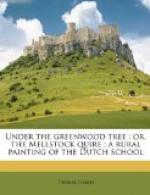Dick, in his consternation at finding Shiner present, was at a loss how to proceed, and retired under a tree to collect his thoughts.
“Here I be, Enoch,” said a voice; and the procession advancing farther, the lantern’s rays illuminated the figure of Geoffrey, awaiting their arrival beside a row of bee-hives, in front of the path. Taking the spade from Enoch, he proceeded to dig two holes in the earth beside the hives, the others standing round in a circle, except Mrs. Day, who deposited her matches in the fork of an apple-tree and returned to the house. The party remaining were now lit up in front by the lantern in their midst, their shadows radiating each way upon the garden-plot like the spokes of a wheel. An apparent embarrassment of Fancy at the presence of Shiner caused a silence in the assembly, during which the preliminaries of execution were arranged, the matches fixed, the stake kindled, the two hives placed over the two holes, and the earth stopped round the edges. Geoffrey then stood erect, and rather more, to straighten his backbone after the digging.
“They were a peculiar family,” said Mr. Shiner, regarding the hives reflectively.
Geoffrey nodded.
“Those holes will be the grave of thousands!” said Fancy. “I think ’tis rather a cruel thing to do.”
Her father shook his head. “No,” he said, tapping the hives to shake the dead bees from their cells, “if you suffocate ’em this way, they only die once: if you fumigate ’em in the new way, they come to life again, and die o’ starvation; so the pangs o’ death be twice upon ’em.”
“I incline to Fancy’s notion,” said Mr. Shiner, laughing lightly.
“The proper way to take honey, so that the bees be neither starved nor murdered, is a puzzling matter,” said the keeper steadily.
“I should like never to take it from them,” said Fancy.
“But ’tis the money,” said Enoch musingly. “For without money man is a shadder!”
The lantern-light had disturbed many bees that had escaped from hives destroyed some days earlier, and, demoralized by affliction, were now getting a living as marauders about the doors of other hives. Several flew round the head and neck of Geoffrey; then darted upon him with an irritated bizz.
Enoch threw down the lantern, and ran off and pushed his head into a currant bush; Fancy scudded up the path; and Mr. Shiner floundered away helter-skelter among the cabbages. Geoffrey stood his ground, unmoved and firm as a rock. Fancy was the first to return, followed by Enoch picking up the lantern. Mr. Shiner still remained invisible.
“Have the craters stung ye?” said Enoch to Geoffrey.
“No, not much—on’y a little here and there,” he said with leisurely solemnity, shaking one bee out of his shirt sleeve, pulling another from among his hair, and two or three more from his neck. The rest looked on during this proceeding with a complacent sense of being out of it,—much as a European nation in a state of internal commotion is watched by its neighbours.




